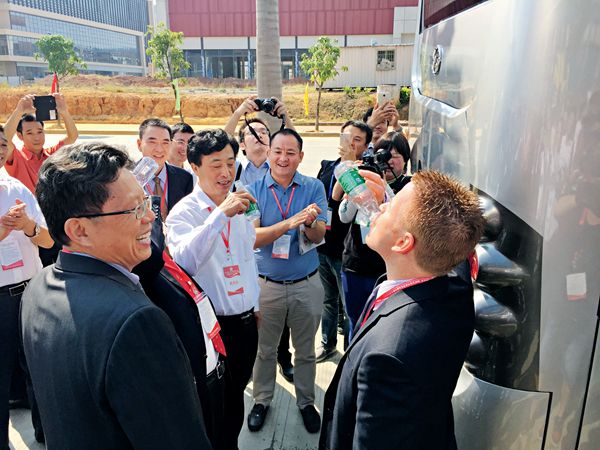By staff reporter ZHOU LIN
By staff reporter ZHOU LIN
TWELVE hydrogen-powered buses went into service last September in Foshan City, Guangdong Province, on China’s first hydrogen fuel cell urban bus demonstration route. The buses were jointly developed and produced by Ballard Power Systems – a Canadian company specializing in global cutting-edge hydrogen fuel cell research and supply – the Energy-Saving and New Energy Vehicle Engineering Center of Tsing-hua University, Guangdong Synergy Hydrogen Power Technology Company Ltd. (“Synergy”), and Foshan Feichi Bus Manufactory Co., Ltd.
Purified Exhaust Pipe Water
“Both Canada and China share a deep concern about protecting the environment and addressing the grave impacts of climate change on our planet,” Canada’s Environment and Climate Change Minister Catherine McKenna told China Today last December in Beijing after her visit to Foshan. The aim of Minister McKenna’s trip was to promote partnerships between Canada and China in efforts to accelerate the shift to a clean growth economy and spur development of clean tech solutions. Both countries thus aim to mitigate the effects of climate change and other environmental challenges.

Canada’s Environment and Climate Change Minister Catherine McKenna gets an onboard introduction to hydrogen fuel cell urban buses in Guangdong’s Foshan-Yunfu Industry Transition Park, as part of her investigation and research mission.
Hydrogen fuel cell vehicles, as the name suggests, run primarily on hydrogen. Hydrogen is an element abundant in the universe which has a higher density than most other energies, second only to nuclear power in this respect. It is environmentally-friendly by virtue of the zero-pollution entailed in both its extraction and usage.
The up-to-the-minute, high-tech look and zero emissions of the first hydrogen fuel cell bus unveiled in October 2015 in Guangdong Province, brought praise and commendation from both local and international guests. Randy MacEwen, president and CEO of Ballard Power Systems, led all present to the exhaust pipe at the back of the vehicle, and announced, “Water coming from the exhaust is purified and can be drunk directly.” He thereupon handed everyone a bottle of the water and proposed a toast.
“As is known to all, we cannot rely solely on wind and solar power to guarantee a steady and constant supply of electric power. Therefore, Canada has developed hydrogen fuel cell technology as an alternative solution,” Minister McKenna told the reporter.
She went on to say that in Canada there is an emerging but reliable supply chain that provides related products and services globally. They include hydrogen fuel cell accessories, testing equipment, and engineering services.
At the same time, the Chinese government has successively promulgated a series of national-level industry support policies. They include: Made in China 2025; the 2016-2020 New Energy Vehicles Promotion and Application Finance Support Policy; and the Energy Technology Innovation Action Plan (2016-2030). The next two years will be critical in determining the leading role that hydrogen fuel cell vehicles will play in the new energy automobiles market.
Factories producing hydrogen fuel cell vehicles are being made in Guangdong’s Foshan-Yunfu Industry Transition Park. No fewer than 5,000 new energy buses are expected to be manufactured there in the coming five years. The park will also be the site of China’s biggest hydrogen energy vehicles production base. A fuel cell stack production line, jointly built by Synergy and Ballard Power Systems, will go into operation in July 2017. It will bridge the gap between China and countries with globally leading techniques in this field, and bring substantial reductions to the cost of hydrogen fuel cells.
Transforming to Clean Growth Economy
“Canada’s clean tech capabilities present terrific potential for Canada-China cooperation in a range of areas, including renewable energy; carbon capture, utilization and storage; smart grid distribution; hydrogen fuel cell technology; and more efficient energy use,” Minister McKenna said. She is convinced that clean tech is one of the most promising industries of the 21st century.

Randy MacEwen, president and CEO of Ballard Power Systems, proposes a toast to the future of Ballard-powered fuel cell buses in China and samples clean water from its exhaust.
“We will bring Canada’s clean tech to China and create opportunities for the two countries’ specialists to cooperate and satisfy one another’s needs,” McKenna said. She believes that now is the perfect time for Canada-China clean tech cooperation, and during this visit she headed a delegation of Canadian clean technology companies to Guangzhou and Beijing. “Enterprises play a crucial role in promoting green economic growth by providing clean and innovative solutions. They therefore need incentivizing policies and a fair, competitive market environment,” McKenna said.
Leading Canadian hydrogen fuel cell companies like Ballard and Hydrogenics, are making breakthroughs in China. In addition to Ballard’s sustained efforts and achievements, Hydrogenics – another Canadian hydrogen and fuel cell manufacturer – has entered into a strategic partnership with SinoHytec, a vehicle propulsion technology company based in Beijing, for the delivery of fuel cells to China. The agreement was to integrate Hydrogenics’ power systems into the buses and trucks of several leading vehicle manufacturers in China during 2016 and 2017.
“The establishment of a clean energy transportation system in China is of huge significance. The current rail transits under construction are all aimed at relieving the environmental pollution generated by traffic congestion,” said Chai Fahe, vice president of the Chinese Research Academy of Environmental Sciences. He then told China Today that the inland logistics system fundamentally depends on trucks and other large vehicles that emit copious quantities of pollutants. Therefore, a new logistics system of rail travel and clean energy, particularly in the heavily polluted Beijing-Tianjin-Hebei Metropolitan Region, will dramatically reduce emissions from diesel powered vehicles.
Moreover, Chinese and Canadian clean energy producers operate in a number of innovative areas, including air pollution control; wastewater treatment and monitoring; soil remediation; power generation; carbon capture, utilization and storage; energy infrastructure; energy efficiency; renewable energy; energy storage; nuclear power; recycling/recovery; and the greening of the extractive sectors (oil, gas, and mining). Canada’s TRIUM Environmental Inc. has signed an MOU with BCEG Environmental Remediation Co. to jointly pursue the soil and groundwater remediation market in China.
Canada is recognized by the International Energy Agency as a global leader in the area of carbon capture, utilization, and storage (CCUS). It is home to three of the world’s 15 operational large-scale CCUS projects. The Saskatchewan Power Corporation’s (SaskPower) Boundary Dam III Project – the world’s first commercial-scale CCUS project of its kind – became fully operational in 2014.
Montreal-based Cansolv Technologies, which supplied the technology used in the Boundary Dam Project to capture CO2 and sulphur dioxide, has a Beijing office. Its technology is being successfully applied in the removal of sulphur dioxide from China’s factories and power plants.
John Zhang, deputy general manager of Cansolv Technologies’ Beijing office, said that the China Guodian Corporation’s Dujun Project in Guizhou Province is the world’s largest regenerative flue-gas desulfurization system. Cansolv Technologies has successfully helped Dujun electric power plant capture sulphur dioxide caused by the combustion of high sulphur coals and also lower the dust emission concentration to a level that accords with the local government’s environmental protection standard. Recycled sulphur resources can annually produce 600,000 tons of 98%wt industrial sulphuric acid, all of which are purchased by a local fertilizer plant, so forming a circular economic industrial chain.
Joining Hands for Sustainable Development
The Paris Agreement was a historic milestone, and people everywhere have their eyes on how this promise will be activated in the future.
At the COP21 Paris Climate Conference in December 2015, China reiterated its commitment to peak CO2 emissions by 2030. China’s 13th Five-Year Plan (2016-2020) includes green development as one of its five principles for long-term economic growth. Minister McKenna indicated that Canada appreciated China’s leadership was key to the coming into force of the Paris Agreement. Engaging with China in clean technology collaboration, therefore, is a top priority for the Canadian Government. Promoting the greening of industries through the increased development and adoption of clean technologies is instrumental to addressing mutual climate change challenges.
The Government of Canada has committed to investing more than C$ 1 billion over the next four years in supporting clean technology. Also, through its Inclusive Innovation Agenda and the Pan-Canadian Framework for Clean Growth and Climate Change, the government has defined a new vision for building Canada into a center of global clean growth and innovation.
Minister McKenna’s mission to China builds on the successful outcomes of Prime Minister Justin Trudeau’s visit to China and of Premier Li Keqiang’s visit to Canada last September. During that period, Prime Minister Trudeau and Premier Li agreed to cooperate in addressing climate change through a full and effective implementation of the Paris Agreement. They also agreed to work together to transition to a clean energy driven economic model. Indeed, China and Canada have several long-standing bilateral working groups, their focus on promoting deeper cooperation in the areas of clean technologies, climate change, and the environment. These include: the Canada-China Climate Change Working Group; the Canada-China Joint Committee on Environmental Cooperation; and the Canada-China Energy Working Group.
“It sounds funny, but I am not joking. Canada is actually concerned with the same challenge that China faces. Though air pollution is not as serious in our country, we nevertheless also suffer from green house gas emissions. I do believe that this is the perfect opportunity for Canada and China to seek more cooperation on clean energy and to exert the leading role in addressing global climate change,” Minister McKenna concluded.
The Paris Agreement came into effect at the COP22 Marrakech 2016 Climate Change Conference. Abundant and constructive multilateral cooperation is being carried out in efforts to combat climate change. Promoting green growth and dealing with climate change are the priorities of both the Chinese and Canadian governments. The two countries will strengthen cooperation, diversify their energy structure, and continue to discover the huge potential of clean tech collaboration, in order to build a green and sustainable prospect.